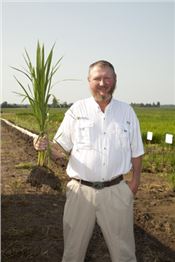Potash Pays

“When it comes to rice, potash is very important,”
says David Dunn, soils testing lab manager at the University
of Missouri Fisher Delta Research Center in Portageville, Missouri.
Photo by John LaRose, Jr.
Rice Fields Treated With Right Amounts Of Potash Thrive
BETTY VALLE GEGG-NAEGER
MidAmerica Farmer Grower
PORTAGEVILLE, MO.
The benefits of potash management for rice was the topic of a talk recently by David Dunn, soils testing lab manager at the University of Missouri Fisher Delta Research Center in Portageville, Missouri.
“When it comes to rice, potash is very important,” he said. “It helps to maintain grain yields, strengthens stalks resulting in less lodging; it provides disease resistance and also improves milling yields and these are things that farmers can take to the bank.”
Dunn gave a summary of 18 years worth of research. When he pooled all this research together, looked at various rates of potash, compared the net returns from those yields he found that rice fields testing 100 lbs. below the target level resulted in a yield loss valued at $160. By maintaining proper potash levels there was no yield loss.
“One of the first things we looked at here at the Delta Center was the Baldo and Bendel varieties of rice,” Dunn reported. “We had some interest in the Baldo variety, an Italian specialty rice. It’s very tall and susceptible to lodging, meaning the plants fall over. The breeders of this rice had recommended that we apply foliar potash late in the season to increase stalk strength. However, we reasoned that we were putting out a mid-season nitrogen application and that there was room in that plane load of fertilizer to include some granular potash too. When we did this, we found we were able to increase our yields by both the mid-season granular and late-season foliar potash applications.
“Our original goal was to reduce lodging,” he added. “When we looked specifically at lodging, we found that the foliar applications of potash late season did reduce lodging; in fact, that cut it in half, 50 percent, a very good benefit to producers.”
This success put them on a roll. They wanted to find a way to measure stalk strength to see if that was related to potash content in the stalks.
“So I developed a system that allowed us to measure stalk strength,” Dunn explained. “A basket was hung from an individual stalk, then weights were progressively added until the stalk failed. This weight was recorded. Next the individual stalks were analyzed for potassium content. There was a direct relationship between content of potassium in the stalk and its breaking point. That led us to do some field evaluations with this method and we found that there’s a direct relationship between stalk strength and lodging. As we approached our target level of recommended potash applied, stalk strength increased and lodging decreased.”
Disease resistance was the next concern. The relationship between sheath blight and potassium fertilization was looked at the past season. Plots receiving either pre-plant or pre-flood K had about half the incidents of sheath blight as the untreated check. “The last thing we looked at was milling quality. We found that as we approached our target levels of pre-plant potash applications both head and whole grain numbers increased. This increased milling yield would allow producers to put more money in their pockets,” he said.
His take-home message is that potash in the right amount maintains yields, increases stalk strength, decreases lodging, reduces disease pressure and improves milling quality. “The bottom line is when it comes to potash ‘don’t guess, soil test’.” ∆
BETTY VALLE GEGG-NAEGER: Senior Staff Writer, MidAmerica Farmer Grower